Report on Sustainable Development: Impacts, Stages, and Measurement
VerifiedAdded on 2020/06/05
|7
|1287
|51
Report
AI Summary
This report delves into the concept of sustainable development within the tourism sector, exploring its goals of preserving natural and human resources for future generations. It identifies factors hindering sustainable tourism, such as recession, safety concerns, and climatic changes, while also analyzing different stages involved in planning for sustainability, from setting aims to recognizing tourism activities. The report further examines the positive and negative impacts of tourism, encompassing economic, social, and environmental effects, and discusses various methods for measuring these impacts, including economic, environmental, and social measures using models like STEAM and Cambridge. It highlights the importance of considering these multifaceted aspects to ensure the long-term viability and positive contributions of the tourism industry.

Sustainable development
Paraphrase This Document
Need a fresh take? Get an instant paraphrase of this document with our AI Paraphraser
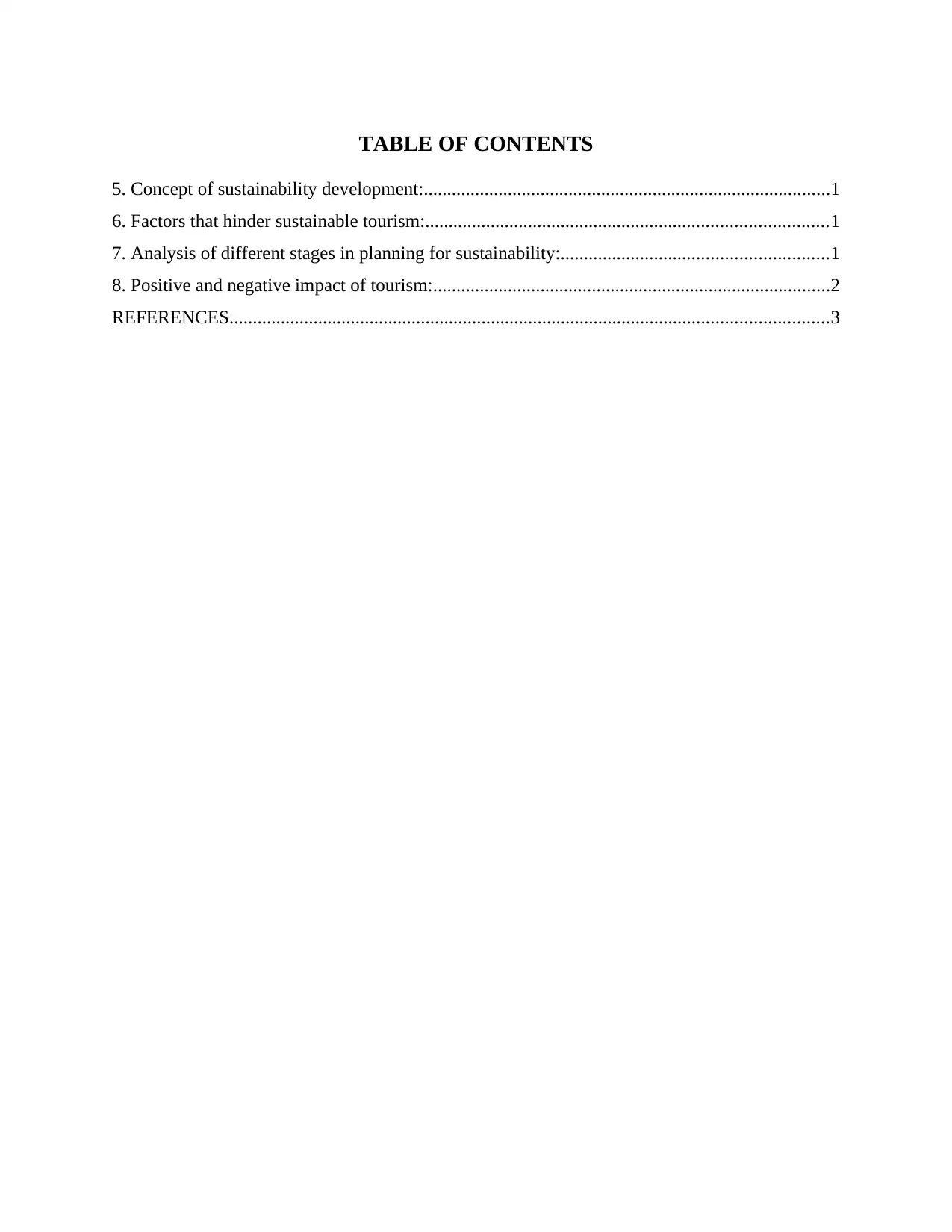
TABLE OF CONTENTS
5. Concept of sustainability development:.......................................................................................1
6. Factors that hinder sustainable tourism:......................................................................................1
7. Analysis of different stages in planning for sustainability:.........................................................1
8. Positive and negative impact of tourism:.....................................................................................2
REFERENCES................................................................................................................................3
5. Concept of sustainability development:.......................................................................................1
6. Factors that hinder sustainable tourism:......................................................................................1
7. Analysis of different stages in planning for sustainability:.........................................................1
8. Positive and negative impact of tourism:.....................................................................................2
REFERENCES................................................................................................................................3
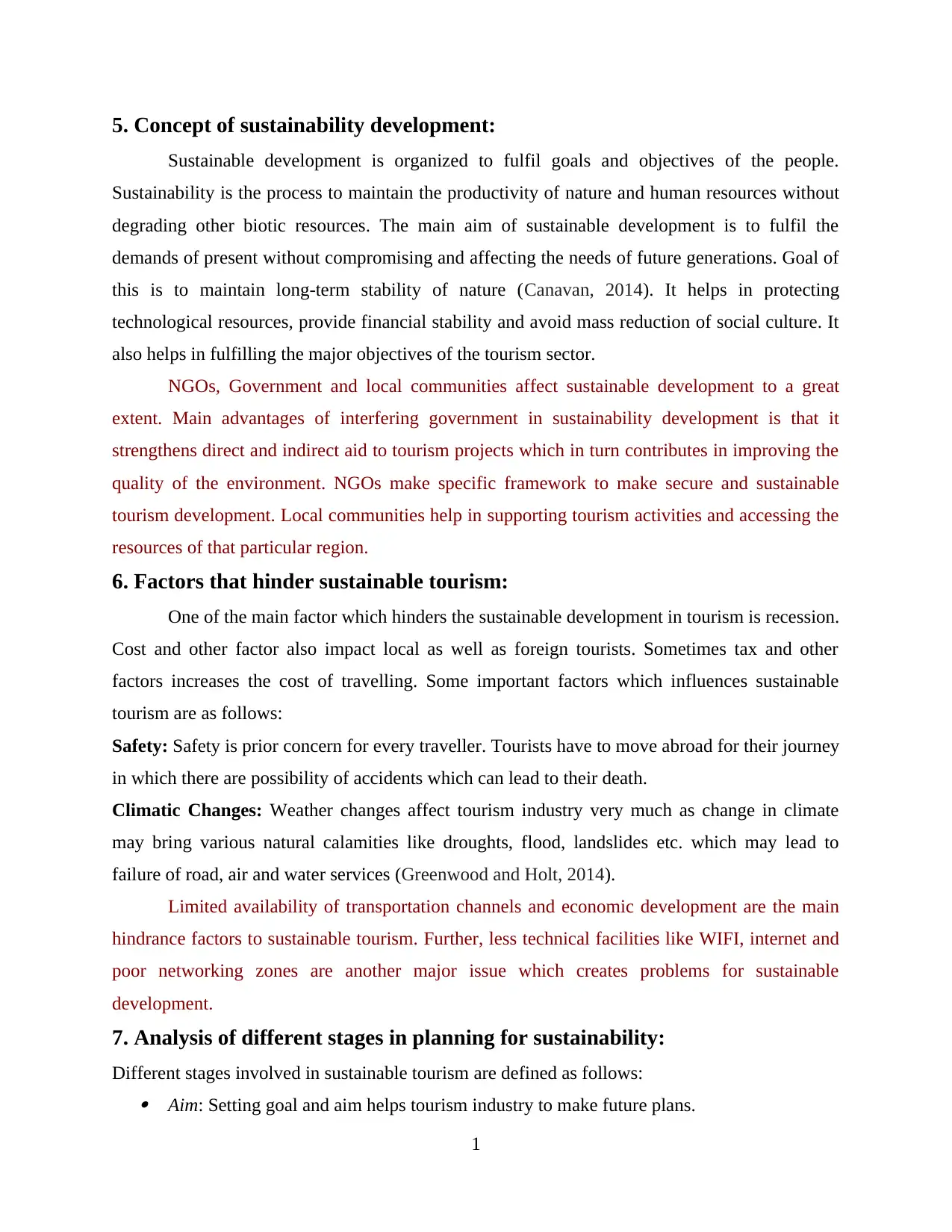
5. Concept of sustainability development:
Sustainable development is organized to fulfil goals and objectives of the people.
Sustainability is the process to maintain the productivity of nature and human resources without
degrading other biotic resources. The main aim of sustainable development is to fulfil the
demands of present without compromising and affecting the needs of future generations. Goal of
this is to maintain long-term stability of nature (Canavan, 2014). It helps in protecting
technological resources, provide financial stability and avoid mass reduction of social culture. It
also helps in fulfilling the major objectives of the tourism sector.
NGOs, Government and local communities affect sustainable development to a great
extent. Main advantages of interfering government in sustainability development is that it
strengthens direct and indirect aid to tourism projects which in turn contributes in improving the
quality of the environment. NGOs make specific framework to make secure and sustainable
tourism development. Local communities help in supporting tourism activities and accessing the
resources of that particular region.
6. Factors that hinder sustainable tourism:
One of the main factor which hinders the sustainable development in tourism is recession.
Cost and other factor also impact local as well as foreign tourists. Sometimes tax and other
factors increases the cost of travelling. Some important factors which influences sustainable
tourism are as follows:
Safety: Safety is prior concern for every traveller. Tourists have to move abroad for their journey
in which there are possibility of accidents which can lead to their death.
Climatic Changes: Weather changes affect tourism industry very much as change in climate
may bring various natural calamities like droughts, flood, landslides etc. which may lead to
failure of road, air and water services (Greenwood and Holt, 2014).
Limited availability of transportation channels and economic development are the main
hindrance factors to sustainable tourism. Further, less technical facilities like WIFI, internet and
poor networking zones are another major issue which creates problems for sustainable
development.
7. Analysis of different stages in planning for sustainability:
Different stages involved in sustainable tourism are defined as follows: Aim: Setting goal and aim helps tourism industry to make future plans.
1
Sustainable development is organized to fulfil goals and objectives of the people.
Sustainability is the process to maintain the productivity of nature and human resources without
degrading other biotic resources. The main aim of sustainable development is to fulfil the
demands of present without compromising and affecting the needs of future generations. Goal of
this is to maintain long-term stability of nature (Canavan, 2014). It helps in protecting
technological resources, provide financial stability and avoid mass reduction of social culture. It
also helps in fulfilling the major objectives of the tourism sector.
NGOs, Government and local communities affect sustainable development to a great
extent. Main advantages of interfering government in sustainability development is that it
strengthens direct and indirect aid to tourism projects which in turn contributes in improving the
quality of the environment. NGOs make specific framework to make secure and sustainable
tourism development. Local communities help in supporting tourism activities and accessing the
resources of that particular region.
6. Factors that hinder sustainable tourism:
One of the main factor which hinders the sustainable development in tourism is recession.
Cost and other factor also impact local as well as foreign tourists. Sometimes tax and other
factors increases the cost of travelling. Some important factors which influences sustainable
tourism are as follows:
Safety: Safety is prior concern for every traveller. Tourists have to move abroad for their journey
in which there are possibility of accidents which can lead to their death.
Climatic Changes: Weather changes affect tourism industry very much as change in climate
may bring various natural calamities like droughts, flood, landslides etc. which may lead to
failure of road, air and water services (Greenwood and Holt, 2014).
Limited availability of transportation channels and economic development are the main
hindrance factors to sustainable tourism. Further, less technical facilities like WIFI, internet and
poor networking zones are another major issue which creates problems for sustainable
development.
7. Analysis of different stages in planning for sustainability:
Different stages involved in sustainable tourism are defined as follows: Aim: Setting goal and aim helps tourism industry to make future plans.
1
⊘ This is a preview!⊘
Do you want full access?
Subscribe today to unlock all pages.

Trusted by 1+ million students worldwide
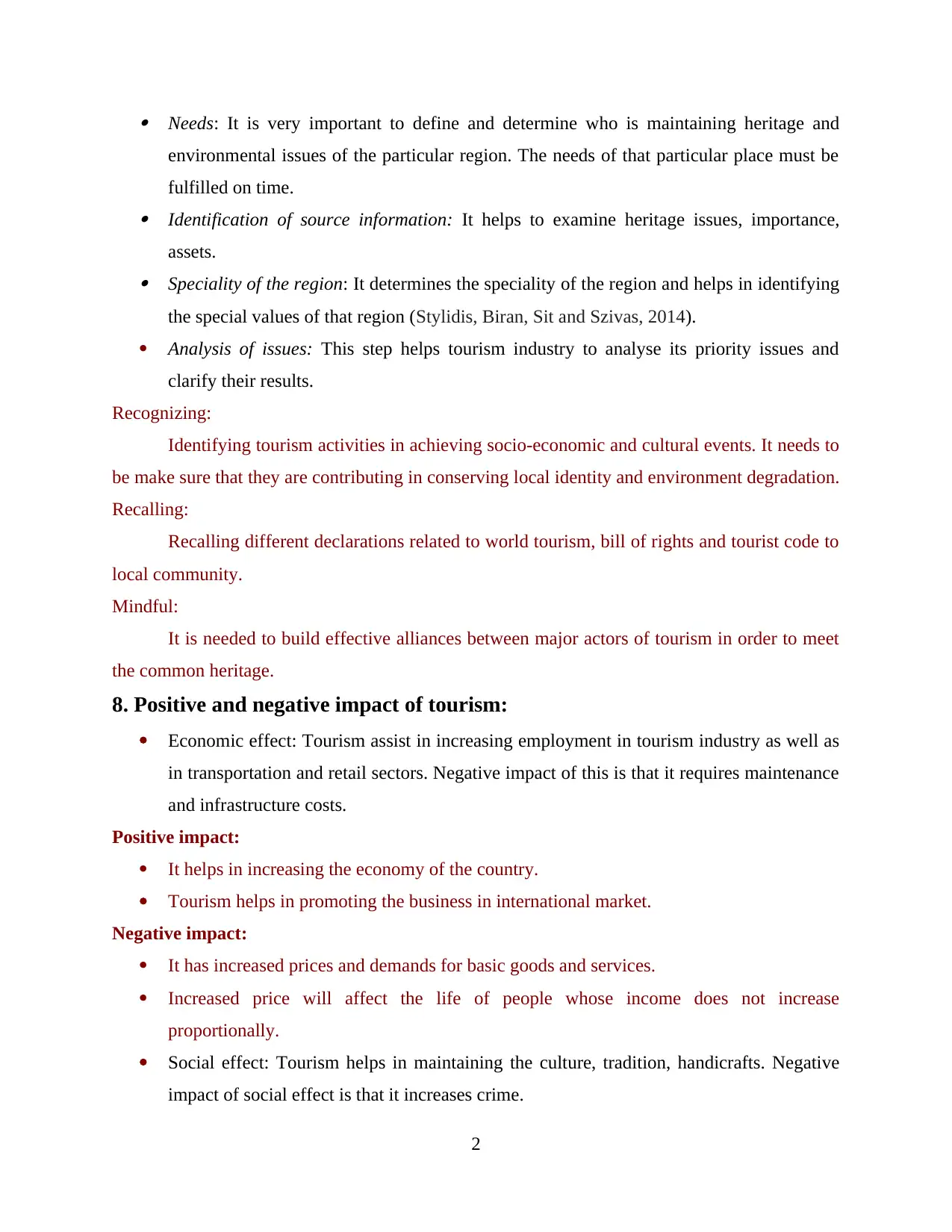
Needs: It is very important to define and determine who is maintaining heritage and
environmental issues of the particular region. The needs of that particular place must be
fulfilled on time. Identification of source information: It helps to examine heritage issues, importance,
assets. Speciality of the region: It determines the speciality of the region and helps in identifying
the special values of that region (Stylidis, Biran, Sit and Szivas, 2014).
Analysis of issues: This step helps tourism industry to analyse its priority issues and
clarify their results.
Recognizing:
Identifying tourism activities in achieving socio-economic and cultural events. It needs to
be make sure that they are contributing in conserving local identity and environment degradation.
Recalling:
Recalling different declarations related to world tourism, bill of rights and tourist code to
local community.
Mindful:
It is needed to build effective alliances between major actors of tourism in order to meet
the common heritage.
8. Positive and negative impact of tourism:
Economic effect: Tourism assist in increasing employment in tourism industry as well as
in transportation and retail sectors. Negative impact of this is that it requires maintenance
and infrastructure costs.
Positive impact:
It helps in increasing the economy of the country.
Tourism helps in promoting the business in international market.
Negative impact:
It has increased prices and demands for basic goods and services.
Increased price will affect the life of people whose income does not increase
proportionally.
Social effect: Tourism helps in maintaining the culture, tradition, handicrafts. Negative
impact of social effect is that it increases crime.
2
environmental issues of the particular region. The needs of that particular place must be
fulfilled on time. Identification of source information: It helps to examine heritage issues, importance,
assets. Speciality of the region: It determines the speciality of the region and helps in identifying
the special values of that region (Stylidis, Biran, Sit and Szivas, 2014).
Analysis of issues: This step helps tourism industry to analyse its priority issues and
clarify their results.
Recognizing:
Identifying tourism activities in achieving socio-economic and cultural events. It needs to
be make sure that they are contributing in conserving local identity and environment degradation.
Recalling:
Recalling different declarations related to world tourism, bill of rights and tourist code to
local community.
Mindful:
It is needed to build effective alliances between major actors of tourism in order to meet
the common heritage.
8. Positive and negative impact of tourism:
Economic effect: Tourism assist in increasing employment in tourism industry as well as
in transportation and retail sectors. Negative impact of this is that it requires maintenance
and infrastructure costs.
Positive impact:
It helps in increasing the economy of the country.
Tourism helps in promoting the business in international market.
Negative impact:
It has increased prices and demands for basic goods and services.
Increased price will affect the life of people whose income does not increase
proportionally.
Social effect: Tourism helps in maintaining the culture, tradition, handicrafts. Negative
impact of social effect is that it increases crime.
2
Paraphrase This Document
Need a fresh take? Get an instant paraphrase of this document with our AI Paraphraser
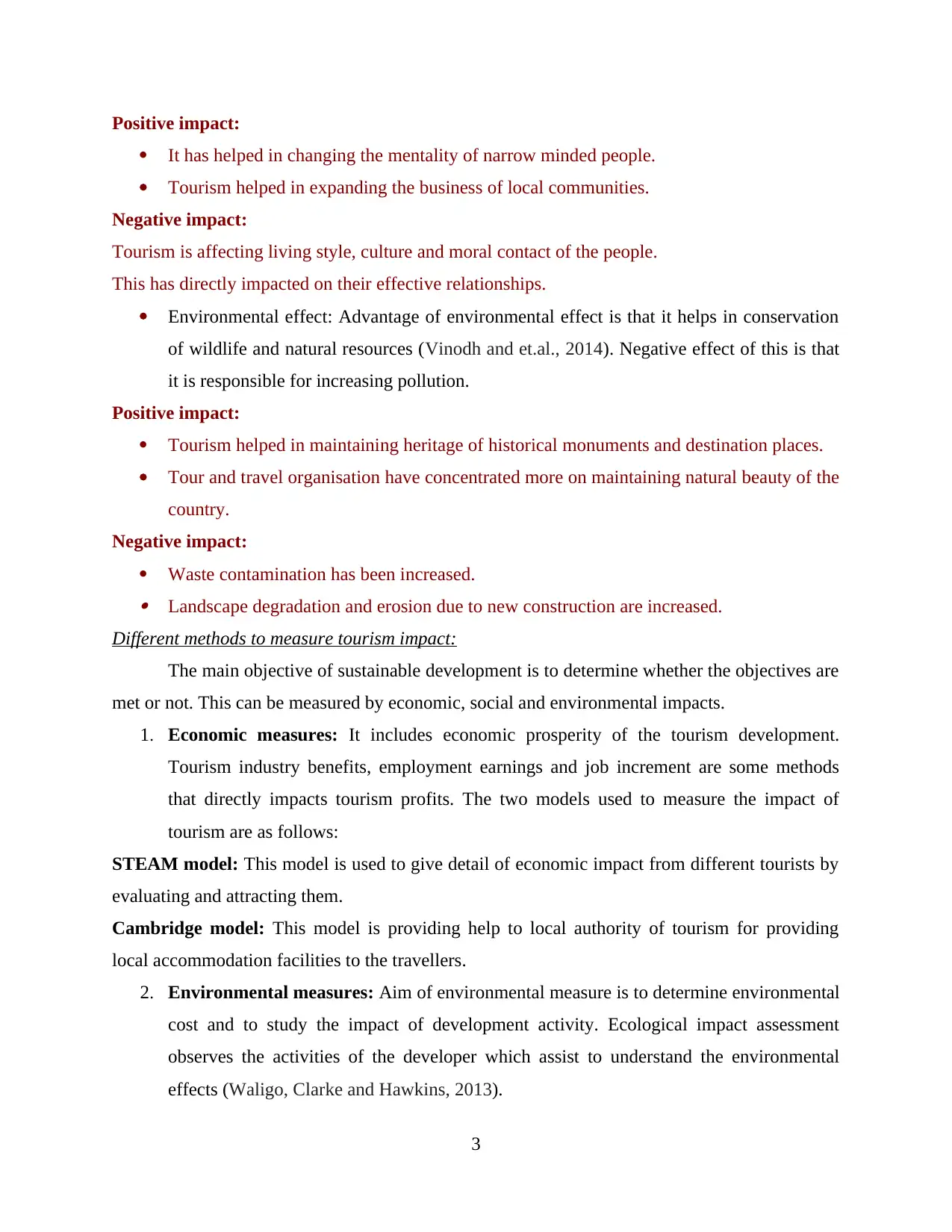
Positive impact:
It has helped in changing the mentality of narrow minded people.
Tourism helped in expanding the business of local communities.
Negative impact:
Tourism is affecting living style, culture and moral contact of the people.
This has directly impacted on their effective relationships.
Environmental effect: Advantage of environmental effect is that it helps in conservation
of wildlife and natural resources (Vinodh and et.al., 2014). Negative effect of this is that
it is responsible for increasing pollution.
Positive impact:
Tourism helped in maintaining heritage of historical monuments and destination places.
Tour and travel organisation have concentrated more on maintaining natural beauty of the
country.
Negative impact:
Waste contamination has been increased. Landscape degradation and erosion due to new construction are increased.
Different methods to measure tourism impact:
The main objective of sustainable development is to determine whether the objectives are
met or not. This can be measured by economic, social and environmental impacts.
1. Economic measures: It includes economic prosperity of the tourism development.
Tourism industry benefits, employment earnings and job increment are some methods
that directly impacts tourism profits. The two models used to measure the impact of
tourism are as follows:
STEAM model: This model is used to give detail of economic impact from different tourists by
evaluating and attracting them.
Cambridge model: This model is providing help to local authority of tourism for providing
local accommodation facilities to the travellers.
2. Environmental measures: Aim of environmental measure is to determine environmental
cost and to study the impact of development activity. Ecological impact assessment
observes the activities of the developer which assist to understand the environmental
effects (Waligo, Clarke and Hawkins, 2013).
3
It has helped in changing the mentality of narrow minded people.
Tourism helped in expanding the business of local communities.
Negative impact:
Tourism is affecting living style, culture and moral contact of the people.
This has directly impacted on their effective relationships.
Environmental effect: Advantage of environmental effect is that it helps in conservation
of wildlife and natural resources (Vinodh and et.al., 2014). Negative effect of this is that
it is responsible for increasing pollution.
Positive impact:
Tourism helped in maintaining heritage of historical monuments and destination places.
Tour and travel organisation have concentrated more on maintaining natural beauty of the
country.
Negative impact:
Waste contamination has been increased. Landscape degradation and erosion due to new construction are increased.
Different methods to measure tourism impact:
The main objective of sustainable development is to determine whether the objectives are
met or not. This can be measured by economic, social and environmental impacts.
1. Economic measures: It includes economic prosperity of the tourism development.
Tourism industry benefits, employment earnings and job increment are some methods
that directly impacts tourism profits. The two models used to measure the impact of
tourism are as follows:
STEAM model: This model is used to give detail of economic impact from different tourists by
evaluating and attracting them.
Cambridge model: This model is providing help to local authority of tourism for providing
local accommodation facilities to the travellers.
2. Environmental measures: Aim of environmental measure is to determine environmental
cost and to study the impact of development activity. Ecological impact assessment
observes the activities of the developer which assist to understand the environmental
effects (Waligo, Clarke and Hawkins, 2013).
3

3. Social measures: Social measures are difficult to measure as they are personal and
qualitative. Different methods are applied to for gathering information. Conducting
surveys, questionnaire and interviews is one of the method by which information about
social measurement can be collected. Second method involves documentaries,
government records and public document.
4
qualitative. Different methods are applied to for gathering information. Conducting
surveys, questionnaire and interviews is one of the method by which information about
social measurement can be collected. Second method involves documentaries,
government records and public document.
4
⊘ This is a preview!⊘
Do you want full access?
Subscribe today to unlock all pages.

Trusted by 1+ million students worldwide
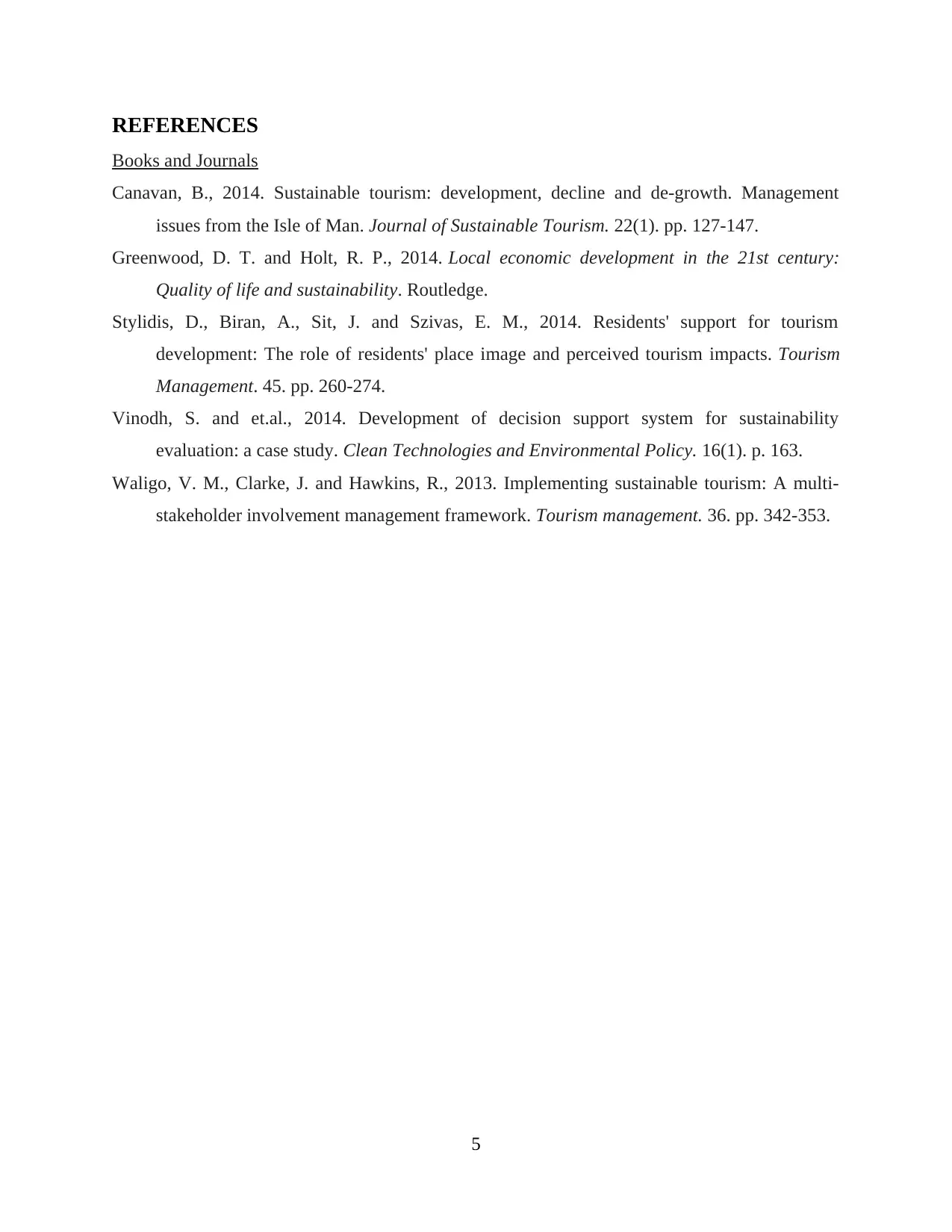
REFERENCES
Books and Journals
Canavan, B., 2014. Sustainable tourism: development, decline and de-growth. Management
issues from the Isle of Man. Journal of Sustainable Tourism. 22(1). pp. 127-147.
Greenwood, D. T. and Holt, R. P., 2014. Local economic development in the 21st century:
Quality of life and sustainability. Routledge.
Stylidis, D., Biran, A., Sit, J. and Szivas, E. M., 2014. Residents' support for tourism
development: The role of residents' place image and perceived tourism impacts. Tourism
Management. 45. pp. 260-274.
Vinodh, S. and et.al., 2014. Development of decision support system for sustainability
evaluation: a case study. Clean Technologies and Environmental Policy. 16(1). p. 163.
Waligo, V. M., Clarke, J. and Hawkins, R., 2013. Implementing sustainable tourism: A multi-
stakeholder involvement management framework. Tourism management. 36. pp. 342-353.
5
Books and Journals
Canavan, B., 2014. Sustainable tourism: development, decline and de-growth. Management
issues from the Isle of Man. Journal of Sustainable Tourism. 22(1). pp. 127-147.
Greenwood, D. T. and Holt, R. P., 2014. Local economic development in the 21st century:
Quality of life and sustainability. Routledge.
Stylidis, D., Biran, A., Sit, J. and Szivas, E. M., 2014. Residents' support for tourism
development: The role of residents' place image and perceived tourism impacts. Tourism
Management. 45. pp. 260-274.
Vinodh, S. and et.al., 2014. Development of decision support system for sustainability
evaluation: a case study. Clean Technologies and Environmental Policy. 16(1). p. 163.
Waligo, V. M., Clarke, J. and Hawkins, R., 2013. Implementing sustainable tourism: A multi-
stakeholder involvement management framework. Tourism management. 36. pp. 342-353.
5
1 out of 7
Related Documents
Your All-in-One AI-Powered Toolkit for Academic Success.
+13062052269
info@desklib.com
Available 24*7 on WhatsApp / Email
![[object Object]](/_next/static/media/star-bottom.7253800d.svg)
Unlock your academic potential
Copyright © 2020–2025 A2Z Services. All Rights Reserved. Developed and managed by ZUCOL.




